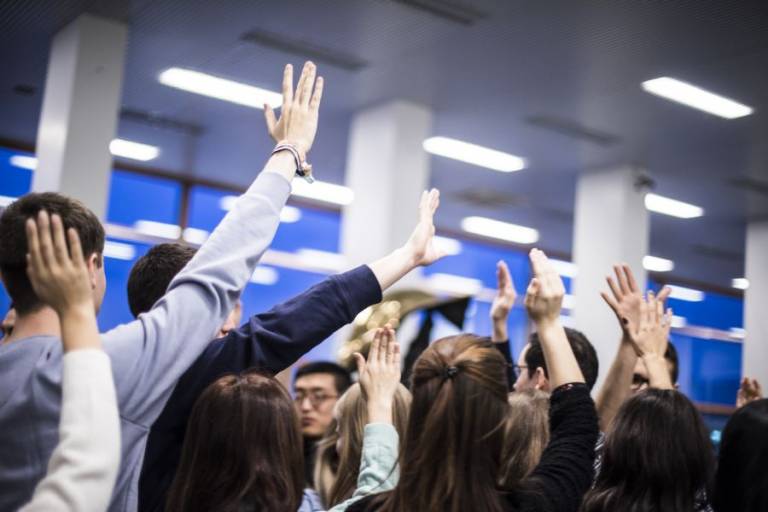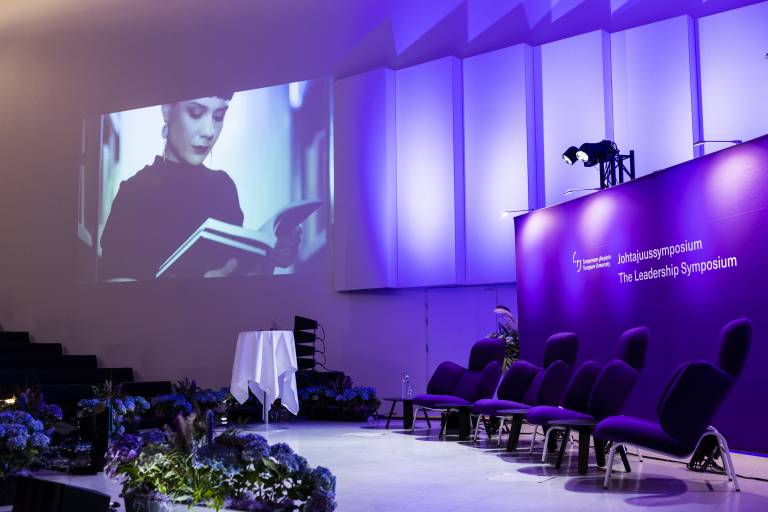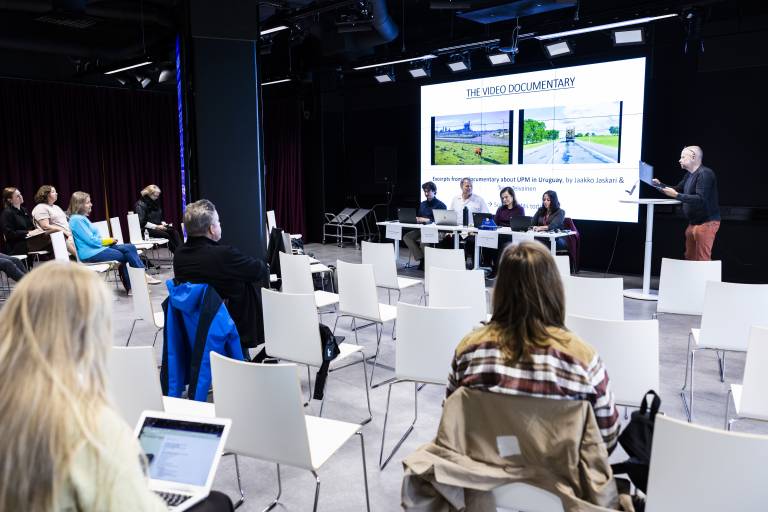Venla Roth’s LFC Lecture was a detailed look into the characteristics and current practical realities regarding the topic of human trafficking both in Finland and the world. The lecture was divided into two main parts. The first, focusing on a detailed description of human trafficking, illustrated the many forms human trafficking may take, how it happens, and where. Next, Venla regarded the efforts required to combat human trafficking. Finally, concluding by identifying and analyzing various actions, some of which the Finnish government had already taken and others that have not yet been handled, are necessary to overcome the war against trafficking in human beings. At the same time, the subject’s challenging nature and concerns were not understated by the audience with numerous questions pouring in only a few minutes after the start of the lecture.
Venla Roth referred to the current representation of human trafficking in the Finnish media. It has been reported that the Finnish Assistance System had admitted more victims of human trafficking than in the previous years. The news of the joint task force being set up by the police in February 2021 to strengthen further the fight against human trafficking was also in the public domain. She described these efforts as pointers to the fact that the government is aware of the issue and is trying to find a lasting solution.
The lecture revealed that human trafficking is related to the following phenomenon: coercing someone into prostitution, labor exploitation, forced marriage, forced adoption, forced begging, and forced criminal activities. Another serious dimension involves trade in human organs and tissues. On the question of where human trafficking occurs, Venla stated that it could happen both locally and internationally, some of which involve organized crime and networks or a single employer in other cases.
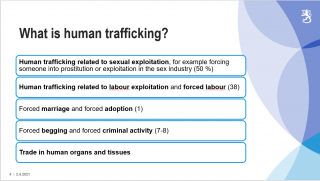
Venla took time to clarify that human trafficking is a process whereby offenders constantly feed on victims’ vulnerability and dependent position. This dependent position is caused mainly by the victim’s lack of language skills and not having any network or connections in Finland. Deception is also identified as a tool in the hands of perpetrators of this crime. She painted a picture that could be called as a circle of misery, where the longer the victims stay exploited, the more traumatized they get, and the harder it gets for them to leave the situation.
Venla drew a connection between the country of origin and the destination country and its role in encouraging or facilitating human trafficking. She mentioned the demand for services rendered by victims of human trafficking, such as sex in destination countries, which, when combined with poverty and inequality in originating countries, acts as a significant driver of human trafficking. It was interesting to learn from the lecture that human trafficking, according to the UN, is one of the highest illegal profit-generating schemes in the world. If culprits are not tracked and tried, such impunity may continue to encourage this nefarious activity.
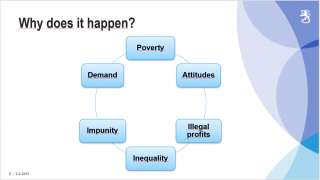
In affecting change, Venla Roth proposed and international and EU level corporative effort given the problem’s transnational and multifaceted nature. She suggested that national governments should strive to implement measures reached by world conferences. According to Venla, anti-trafficking actions are usually divided into three complementary parts:
- Preventive measures are put in place against human trafficking.
- Where anyone is being suspected of aiding and abetting the crime, investigations should be carried out followed by prosecution and, if found guilty, made to face the full extent of the law.
- Victims should be assisted and protected.
Venla said the state’s role in combating, preventing, and assisting human trafficking is crucial. Although people often don’t think about human trafficking in their daily lives, people must recognize human trafficking as a social issue requiring political attention. She believes that it’s not the primary role of individuals to identify victims of human trafficking and ask for help. However, she mentioned that everyone could discuss the problem and ask the government about their actual actions on this issue.
In contrast to Finland, she also stated that in developing countries, you encounter a series of complex problems. For example, due to high levels of corruption and poverty, economic depression, women’s lower status in society and unwillingness to exercise authority, the people become more victimized, and it is easier to exploit them. However, Finland is a country with less corruption, a robust infrastructure, high-level social welfare, and a prominent level of gender equality, which can help in combating human trafficking.
Venla Roth pointed out that not only we will use border guards, social health departments, police, and labor inspectors to find victims of human trafficking, but we also need to hire language teachers, companies, and labor unions. We need to understand that the trafficked persons are ordinary people, their lives are like ours, and they need what we need. She emphasized that trafficked people need to clean up when we go to the office or restaurant, and it is imperative to know the people we meet.
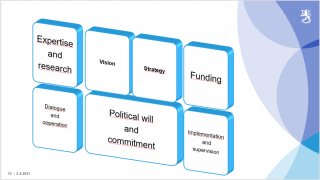
She told that the Finnish government currently has a project coordinated by the “National Assistance System”. They cooperate with companies, NGOs, and labor unions to create jobs for victims of human trafficking for making sustainable solutions. Venla also mentioned that NGOs are more likely to encounter disadvantaged groups and build trust in victims by being closer to them. In contrast, victims of human trafficking are afraid to go to government departments because they may have had bad experiences or negative impressions of authorities.
Venla averred that the more you look at it, the more you will discover that there should be a strategy to combat human trafficking. In this regard, she mentioned that if we do not investigate and disclose trafficking cases, it will be difficult to conduct further investigations. She also stated that human trafficking has been developing and changing, and it has been emerging in new forms. For example, according to Venla, the number of victims who enter the assistance system is typically identified more significantly in Finland’s catering and cleaning industries.
However, Venla found a barrier between the Finnish legislation and different practices for the victims of human trafficking, which makes it harder for them to come forward. Venla gave a curious example: There’s a person in Finland who has a job and a work-related residence permit. It is hard for them to come forward and talk about the exploitation without an alternative to stay in the country. In this regard, Finland could introduce a new residence permit criterion for the victims of human trafficking to come forward and apply for that kind of residence permit without being afraid of deportation.
Venla Roth found that one of the obstacles regarding trafficking is related to the residence permit, because it takes a long time for the authorities to consider whether the person is entitled to get a residence permit or not. Under the law of the migration services, the victims of human trafficking do not have the right to work during that time, and this is an issue that must be considered as to whether these rights should be continued. Venla also said that Finland is now trying to develop various kinds of anti-trafficking action strategies by reviewing the problems and drawbacks in the current legislation that would make it easier for the victims of human trafficking to come forward.
Venla believes that the current Finnish legislation is good concerning prostitution and pandering. However, she believes that concerning prostitution, licensing will not solve the problem, and strict regulatory legislation can play a crucial role in preventing the most exploitative trafficking activities. Venla says that most people who are sexually exploited are women and girls both in Finland and internationally. She also stated that in Finland, human trafficking started with sexual exploitation. According to Venla, Finland is quite good at identifying labor exploitation if compared to other Nordic countries.
Venla replied that a finding from UN Women’s research during COVID-19 is that trafficking has shifted more to online pornography, while fewer people moved across the border. Although, she emphasized that more research should be done on this. She also mentioned that if someone is exploited for sexual harassment or labor exploitation, the victim can contact the National Assistance System and the NGOs working in different cities of Finland on human trafficking. She also told us that if you suspect that someone around you has been victimized due to labor or sexual exploitation, you can discuss the issue with him or her first, and then you can inform an expert to assist victims of human trafficking.
Venla pointed out that the Council of Europe provides well-structured recommendations as human rights instruments that Finland has received and is working on. Moreover, Finland has received many suggestions from the ‘Group of Experts on Action against Trafficking in Human Beings’ (GRETA) to rectify the convention in 2012. Since then, Finland has received two reports from GRETA that have been taken seriously. Accordingly, Finland is now drafting the international plan of action following GRETA’s various recommendations. Venla stated that the Ministry of Social Affairs and Health in Finland has also established a working group. The policymakers discuss how the legislation for the victims of human trafficking would improve the victims’ status. Thus, victims could be assisted with lesser connections to criminal proceedings.
Venla expressed that many international organizations, including the United Nations Office on Drugs and Crime (UNODC) at Vienna and the European Commission, are showing interest to combat human trafficking through adopting new strategies. Accordingly, Finland is also cooperating with its important Nordic partner countries and the OSCE Office for DROthemocratic Institutions and Human Rights (ODIHR) in Warsaw that provides support, assistance, and expertise to participating states and civil society considering the rule of law, human rights, tolerance, and non-discrimination. The Organization for Security and Cooperation in Europe has been especially active in this issue.
According to Venla, Finland is developing a ‘National Referral Mechanism’ for the victims of human trafficking. She also informed that Finland is organizing a seminar on human trafficking in the coming November during the Finnish presidency in the Nordic Council of Ministers. Moreover, the Council of Europe is involved with rectifying the convention on action against human trafficking, where Finland is constantly monitoring how they implement those conventions.
Concluding the LFC Lecture, Venla Roth urged the students and wider audience to address these complex social issues in their education and professional lives to create a better world for the next generation.
We thank Venla Roth for the thought-provoking lecture and our audience for active participation during the event!
The Leadership for Change Lecture with Venla Roth was organised by Vilma Kivinen, Yahya Sonko, Nonso Emezie, Mashiur Rahman, and Robert Stewart. The blog post was written by Mashiur Rahman and Nonso Emezie.


